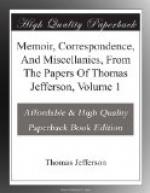If we determine that a Dollar shall be our Unit, we must then say with precision what a Dollar is. This coin, struck at different times, of different weights and fineness, is of different values. Sir Isaac Newton’s assay and representation to the Lords of the Treasury, in 1717, of those which he examined, make their values as follows:
[Illustration: Sir Isaac Newton’s Assay, page137]
The Seville piece of eight . . . . 387 grains of pure silver The Mexico piece of eight . . . . 385 1/2 " The Pillar piece of eight . . . . 385 3/4 " The new Seville piece of eight . . 308 7/10 "
The Financier states the old Dollar as containing 376 grains of fine silver, and the new 365 grains. If the Dollars circulating among us be of every date equally, we should examine the quantity of pure metal in each, and from them form an average for our Unit. This is a work proper to be committed to mathematicians as well as merchants, and which should be decided on actual and accurate experiment.
The quantum of alloy is also to be decided. Some is necessary, to prevent the coin from wearing too fast; too much, fills our pockets with copper, instead of silver. The silver coin assayed by Sir Isaac Newton, varied from 1 1/2 to 76 pennyweights alloy, in the pound troy of mixed metal. The British standard has 18 dwt.; the Spanish coins assayed by Sir Isaac Newton, have from 18 to 19 1/2 dwt.; the new French crown has in fact 19 1/2, though by edict it should have 20 dwt., that is 1/12.
The taste of our countrymen will require, that their furniture plate should be as good as the British standard. Taste cannot be controlled by law. Let it then give the law, in a point which is indifferent to a certain degree. Let the Legislatures fix the alloy of furniture plate at 18 dwt., the British standard, and Congress that of their coin at one ounce in the pound, the French standard. This proportion has been found convenient for the alloy of gold coin, and it will simplify the system of our mint to alloy both metals in the same degree. The coin too, being the least pure, will be the less easily melted into plate. These reasons are light, indeed, and, of course, will only weigh, if no heavier ones can be opposed to them.
The proportion between the values of gold and silver is a mercantile problem altogether. It would be inaccurate to fix it by the popular exchanges of a half Joe for eight dollars, a Louis for four French crowns, or five Louis for twenty-three dollars. The first of these, would be to adopt the Spanish proportion between gold and silver; the second, the French; the third, a mere popular barter, wherein convenience is consulted more than accuracy. The legal proportion in Spain is 16 for 1; in England, 15 1/2 for 1; in France, 15 for 1. The Spaniards and English are found, in experience, to retain an over proportion of gold coins, and to lose their silver. The French have a greater proportion of silver.




